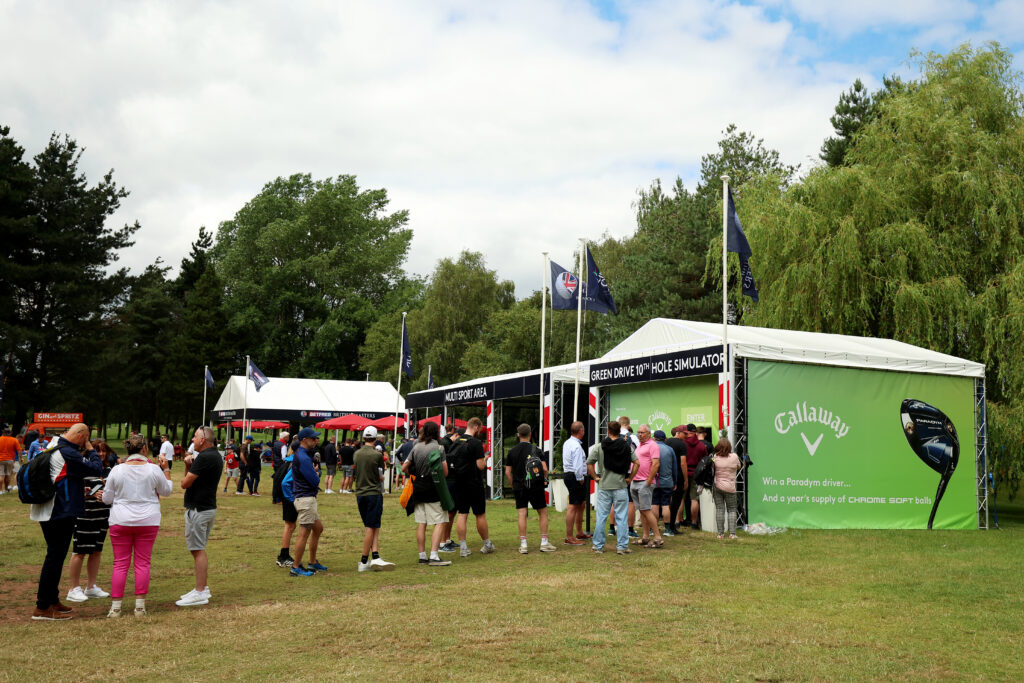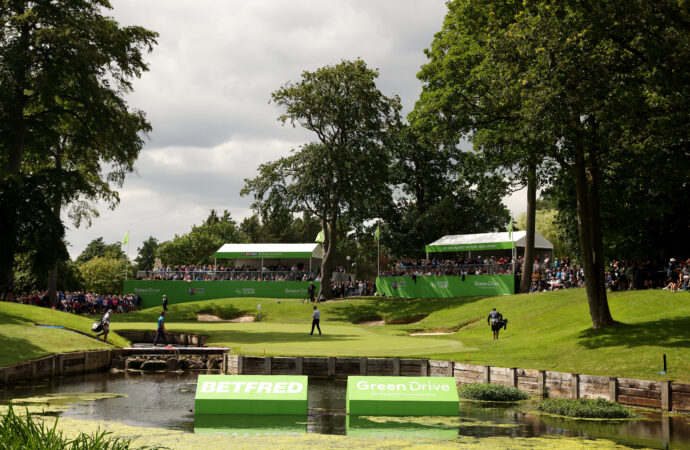Andrew Lynch, head of sustainability at The European Tour, discusses how the organisation is reframing a popular environmental initiative to engage golf fans with sustainability
Tree planting is the most common scheme that sports organisations adopt to show care for the environment, but rather than using it as an offsetting measure – the faults in that being well documented – what if tree planting was used for another purpose entirely?
At the 2023 British Masters, held last month at the Belfry near Birmingham, The European Tour planted 100 trees for every player able to drive the 10th hole green with their tee shot and reach the green on the 319-yard par 4. On a simulator built next to the tee, every successful fan attempt at achieving the same feat also led to 100 trees being planted. On Saturday and the tournament’s third day, three fans who were closest to the pin on the simulator tried to replicate their effort on the actual tee in front of packed grandstands.

The striking difference in the Belfry’s 10th hole compared to the average golf hole was immediately obvious to fans on course. Awash in green and a grandstand DJ created a party atmosphere surrounding the simple message that each player driving the green meant 100 trees being planted.
As a result of the scheme, 2,600 trees will be planted a few miles from the Belfry in the Forest of Mercia.
“I think it’s important to state that the planting trees for us here wasn’t an offsetting initiative,” Andrew Lynch, head of sustainability at The European Tour, tells The Sustainability Report. “There are a whole raft of sustainability initiatives that can have more environmental and positive environmental impacts than planting trees. This was just simply to raise awareness of the global climate crisis that we face. We thought it was a very easily digestible metric for fans to understand. We want fans to not be dismissive of the concept and the journey we are trying to bring them on. But there is a lot of fans out there who just don’t understand yet.”
But what do The European Tour do once fans are on board? “We need to decide if it is worth us looking into other areas where we can have greater environmental impact, such as blue carbon and planting seagrass,” says Lynch.
This was considered for the Scottish Open beginning today at The Renaissance Club, a links course in North Berwick; five square metres of seagrass for every green driven, to give an example. However, the same tree planting initiative will occur here, as well as at the World Championships season finale in Dubai in November, with initiatives beyond tree planting lying on the horizon for 2024 and beyond.
In addition to fans on The European Tour’s courses, the organisation has over 2.2 million followers across its social media platforms. Add TV viewers to the mix and environmental engagement initiatives such as the British Masters’ 10th hole reach a vast audience.

But how do The European Tour measure what exactly these fans are taking on board? It’s all well and good for a golf fan to be watching from their sofa and thinking, ‘This is a good initiative!’, but are they actually learning about sustainability and taking action in their everyday lives?
“We have a benchmark from a carbon emissions perspective, but we’ve also benchmarked from fan surveys of their awareness about what we’re doing across our sustainability platform,” tells Lynch. The European Tour includes fan emissions in its carbon calculations, so both post-event and annual surveys including behavioural questions that help inform the Tour’s approach to hosting events.
What about the wider sustainability strategy?
The European Tour’s Green Drive sustainability strategy, delivered with support from the GEO Foundation for Sustainable Golf, commits the organisation to reducing their carbon footprint by 50% by 2030 and being net zero by 2030. It is also a signatory to the United Nations Sport for Climate Action Framework and the United Nations Race to Zero pledge.
Green Drive is extensive, and, as Lynch puts it, “not just reusable water bottles and planting trees.” Some of The European Tour’s headline events include the Rolex Series (of which all tournaments are carbon neutral – albeit using Gold Standard offsets where emissions are unavoidable) and European-hosted Ryder Cups, which this September will be held at Marco Simone Golf and Country Club in Guidonia Montecelio near Rome.
When Green Drive was launched in 2021, The European Tour began developing an extended 10-year sustainability strategy for the Ryder Cup, which Lynch describes as a “beast of an event”, reflecting on a build process that takes nine months. Grandstands, railings and hospitality structures at Marco Simone started going up in February, and Lynch acknowledges the “huge footprint” that comes with an infrastructure project that big.
In a city like Rome, where water scarcity is a major environmental risk, Lynch explains that one of his key priorities is monitoring its provision on course, making sure there is enough for players, caddies and fans.
Suppliers showing interest in the Ryder Cup must demonstrate how their products and services help The European Tour meet its sustainability targets, with tentage, signage and food provision necessitating the highest standards of sustainability.
Thankfully for Lynch, many suppliers in his procurement chain are “very much walking the walk”, making it a “lot easier” to deliver sustainable events, even on the Ryder Cup’s scale.
“We can only be as good front of house as those back of house,” he says. “It’s actually really heat-warming to see the amount of suppliers that have already got pretty robust sustainability credentials, bearing in mind how relatively new this is to the corporate world.”
Crowds of people will travel to Italy for the tournament; staff as well as fans. One of The European Tour’s strategic goals in Green Drive is incentivising staff to find operational efficiencies, and further developing staff travel policy, guidance and incentives.
Lynch has no choice but to scrutinise whether an event will still be able to operate without particular staff members being on site, and if they can do their job remotely, if net zero carbon by 2040 is to be achieved.
“If we take our domestic travel policy as an example, much of our staff are based in the London area,” Lynch explains. “Historically, people would have flown from London to Edinburgh, rented a car and travelled [to the Scottish Open] that way. But now, it’s a train first policy and it will also be the same for the Open de France in Paris.” This change comes as a result of the “huge cultural change internally”, aided by the calendar increasingly grouping events regionally to minimise travel between them.
In June, the bombshell that the PGA Tour, LIV Golf and The European Tour would be merging under a single organisation was announced. How exactly this will affect The European Tour’s sustainability strategy is a complex issue, but, with an optimistic outlook, perhaps a Green Drive hole will be complementing the green jacket at Augusta National and The Masters before long.
Opt into our weekly newsletter for exclusive content focused on sustainability strategy, communication and leadership for sport’s ecosystem.










Leave a Comment
Your email address will not be published. Required fields are marked with *